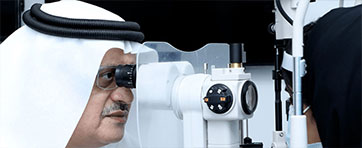Keratoconus
published on: 02nd june, 2021
Keratoconus
Dr. Ameen Saleh Ali Al-Saleemis an Ophthalmologist Consultant, Chief Ophthalmic Surgeon, and Chief Executive Officer of Samaya Specialized Center. He has been awarded the Lifelong Education for Ophthalmologist by the American Academy of Ophthalmology. He is a proud member of the American Academy of Ophthalmologists, European Society of Cataract and Refractive Surgeries and International Society of Refractive Surgery, and has full registration in Pakistan Medical & Dental Council.
What is Keratoconus?
Keratoconus is an ectatic corneal disease characterized by progressive stromal thinning, irregular astigmatism, and defective vision. It can be unilateral or bilateral with asymmetric presentation. It starts at puberty and either progresses rapidly to an advanced stage of the disease or stops in case of delayed onset and slow progression. In the past few years we have seen a great acceleration of discoveries in the field of keratoconus including new treatments, diagnostic tools, genomic and molecular determinants of disease risk.
What are the Causes of Keratoconus?
Weakeningof the corneal tissue (corneal stroma) Imbalance of enzymes within the cornea
Cornea is more susceptible to oxidative damage from compounds called
*free radicals,causing the cornea to weaken and bulge forward
*Free radicalsbreaks down the bond between collagen fibers cross-links leading to bulging of the cornea such as that of a cone that resulted in the thinning and irregular cornea
Genetic predisposition
How is Keratoconus Treated?
- Mildest form of keratoconus (GR 1) - C3R and after one year as per doctor's advice, TICL
- Moderate to Advance (GR 2 and GR 3) - ICR, Corneal Cross-Linking (CXL), TICL
- Advance to End Stage (GR 4 to GR 5) - Corneal Transplant (most notably for end stage Keratoconus patients, presenting corneal scar)
What are the outcomes of Keratoconus Treatments?
- restoration of vision
- enhancing tectonic integrity
References:
Mandathara, Preeji S.; Stapleton, Fiona J.; Willcox, Mark D. P. (2016). Outcome of Keratoconus Management. Eye & Contact Lens: Science & Clinical Practice, (), 1–. doi:10.1097/icl.0000000000000270 Anitha, V., Vanathi, M., Raghavan, A., Rajaraman, R., Ravindran, M., & Tandon, R. (2021). Pediatric keratoconus-Current perspectives and clinical challenges. Indian Journal of Ophthalmology, 69(2), 214.
Alió del Barrio, J. L., El Zarif, M., de Migel, M. P., Azaar, A., Makdissy, N., Harb, W., … Alió, J. L. (2017). Cellular Therapy With Human Autologous Adipose- Derived Adult Stem Cells for Advanced Keratoconus. Cornea, 36(8), 952–960. doi:10.1097/ico.0000000000001228
1 Bykhovskaya, Y., & Rabinowitz, Y. S. (2020). Update on the genetics of keratoconus. Experimental Eye Research, 108398. doi:10.1016/j.exer.2020.108398
recent posts
- Understanding Blepharitis: Causes, Symptoms, and Treatment Options
- The Role of Technology in Cataract Surgery: Abu Dhabi's Latest Techniques
- Understanding Keratoconus: Causes, Symptoms, and Diagnosis in Abu Dhabi
- Clearing the Fog: Understanding Glaucoma's Silent Threat to Vision
- Battling the Eye's Bumps: All You Need to Know About Pinguecula
- Understanding Pinguecula: Causes, Symptoms, and Management
- What Should I Consider When Choosing the Best Eye Hospital in Abu Dhabi?
- What is Diabetic Retinopathy?
- Diabetic Retinopathy
- What is Glaucoma?
- Eye Squint (Strabismus)
- Cataract
- Dry Eyes Syndrome
- Chalazion
2024. All Rights Reserved Samaya Specialized Center
